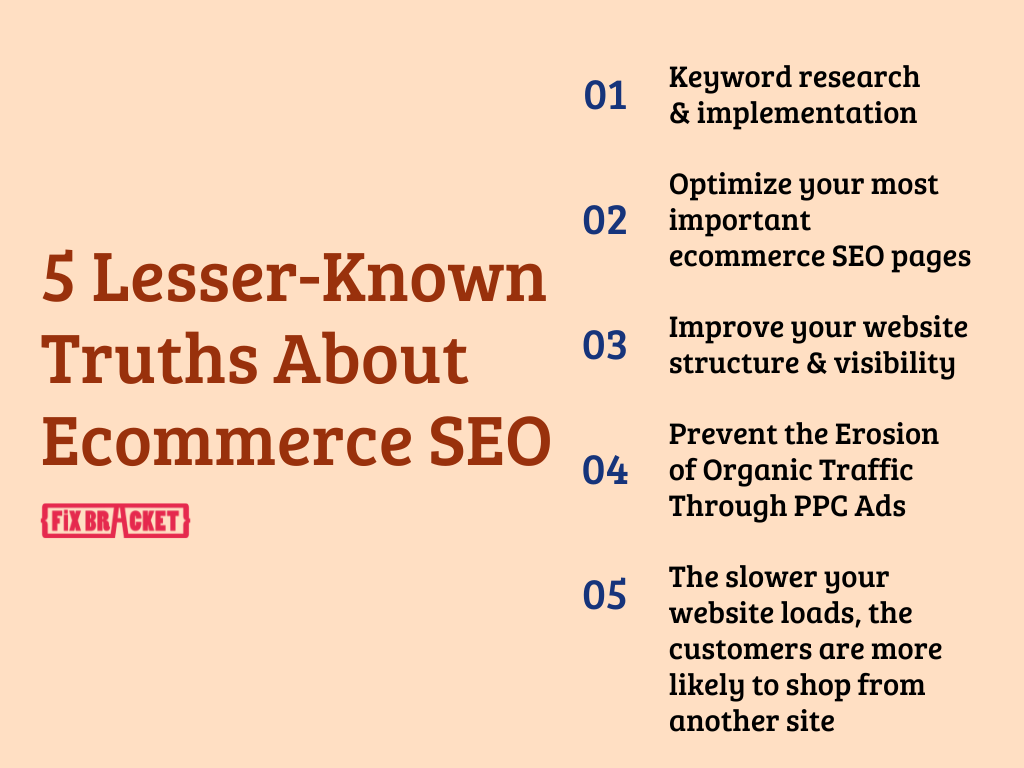SEO Truths that ecommerce brands need to know.

Image source: www.pexels.com
Here’s the deal: a lot of online stores are struggling because they’re not getting enough people visiting their site, and when folks do drop by, they’re not buying anything. The main reason for this is poor ecommerce SEO.
But guess what?
Even with all the competition out there, there’s a way to fix it. Just get your hands on the right marketing plan. That means attracting more customers and making sure they stick around long enough to buy something.
Now, the secret sauce in a killer ecommerce marketing plan is a solid search engine optimization (SEO) strategy. Ecommerce SEO isn’t very different from on-site SEO through blogs. The general principle is the same, however, many factors are unique.
In this article, we will discuss what ecommerce SEO is and the ten best hacks that we’ve found on the internet to boost revenue and sales as an ecommerce company. So let’s get right into it!
What Is E-commerce SEO?

Imagine you’ve got this online store, right? You’re selling cool stuff, but there’s a hitch – not enough people are checking out your goods. That’s where e-commerce SEO swoops in to save the day.
Picture SEO as your online store’s personal cheerleader, but instead of waving pom-poms, it’s optimizing your website so search engines (like Google) can rank it up in its search results.
Why does that matter?
Well, when someone types “awesome gadgets” into Google, you want your store to pop up on the first page, right? That’s where the magic of ecommerce SEO kicks in.
Let’s dig into the nitty-gritty. First up, keywords – these are the words and phrases people type into search engines. Pick the right ones, and voila! Your store becomes more visible. Think of it as speaking the language of your customers. If they’re searching for “stylish sneakers,” make sure your site shouts, “Hey, we’ve got the coolest kicks in town!”
Then there’s the behind-the-scenes tech stuff. Your website needs to load faster than a microwave heats leftovers. Slow sites? Ain’t nobody got time for that. Search engines like speedy pages, and so do your customers.
Now, links are like the internet’s version of a recommendation. The more reputable websites that link to yours, the more search engines trust your store. It’s like your friend saying, “Hey, check out this amazing online shop!”
Oh, and don’t forget about mobile-friendliness. Everyone’s glued to their phones, right? If your site looks wonky on mobile, people will bounce faster than you can say “add to cart.”
Lastly, fresh content is key. Regularly update your site with blogs, product descriptions, and other cool content. It tells search engines, “Hey, we’re alive and kicking – show us some love!”
So, ecommerce SEO is your online wingman, making sure your store shines in the digital aisles of the internet. Get it right, and those virtual cash registers will be ringing in no time.
Top 5 Lesser-Known Truths About Ecommerce SEO
After scouring the web for hours and getting deep insights into ecommerce SEO, we came up with these ten hacks, tips, or as we like to call them, truths of ecommerce SEO.
The first one may not be a lesser-known truth about ecommerce SEO, however, it is so fundamental to SEO in general that we couldn’t just skip it. So let’s get started with our list of lesser-known ecommerce SEO truths.

1. Keyword Research and Implementation
Keywords play a pivotal role in determining the visibility of your ecommerce website in search results when potential customers are seeking products available on your platform. Selecting the right keywords is imperative for the success of your ecommerce venture.
To identify the most effective keywords for your business, consider utilizing tools such as Google’s Keyword Planner or Bing’s Keyword Research Tools. These tools provide insights into popular and relevant keywords. Once you assess the competition and popularity of specific keywords, you can strategically choose those that align with your business objectives.
For products and services facing intense competition, opting for broad match keywords is a prudent strategy. Additionally, when targeting local markets, it is crucial to ensure accurate translations and spellings. Employing native-speaking translators is recommended, as automated translations may fall short of conveying nuanced language intricacies.
In essence, the selection of keywords serves as a cornerstone for optimizing your ecommerce website’s performance. Attaining a nuanced understanding of your target audience’s search behavior and preferences will contribute significantly to the efficacy of your keyword strategy.
2. Optimize your most important ecommerce SEO pages
When undertaking SEO promotion for your online store website, prioritize key pages such as the homepage, product cards, category pages, and blog posts. These pages hold significant visibility, influencing user engagement considerably.
Consider the following tips for optimizing these crucial pages:
Searchable URLs:
Employ clear, uncomplicated URLs that are easily interpreted by both users and search engines. Steer clear of using numbers, uncommon symbols, or arbitrary letter combinations.
Optimizing Product Pages:
- Elevating the visibility of product pages involves a multi-step process.
- Craft concise yet informative descriptions, not exceeding 1000 words for each product. Include details like size, features, and colors, and incorporate customer reviews and responses to frequently asked questions.
- Address out-of-stock pages thoughtfully. Rather than a 404 error, maintain the page with a clear indication that the item is temporarily unavailable. Suggest alternative products and provide an option for email notifications when the product becomes available.
- Leverage snippets effectively. Include pertinent information such as stock availability, reviews, ratings, store addresses, and other relevant details.
Optimizing Categories:
- Enhance category pages with strategic optimizations.
- Integrate links to related products within the same theme. For instance, if your store sells helmets, consider linking to related items like gloves or boots, emphasizing a cohesive offering of personal protective equipment.
By implementing these optimization strategies, you can bolster the overall performance and visibility of your online store, ensuring a positive user experience and favorability with search engines.
3. Improve your website structure & visibility
Always keep in mind that your online store is for your customers. Hold each client accountable and ensure the site is as user-friendly as possible – you don’t want them bouncing off as soon as they open it.
The structure of an online store is a crucial element in the comprehensive promotion of an eCommerce project. When crafting the site’s structure, considerations include the principles of thematic information classification (moving from general concepts to specific ones), relevant search queries, and ensuring user convenience in finding essential information.
As some topics may make thematic classification for product searches inconvenient, the site can employ various methods to classify and structure the same products, facilitating quicker user discovery. One classifier may take the lead, while others serve as supporting structures. Designing a site structure is a meticulous and time-consuming process involving information processing, subsequent structuring, and visualization.
Facilitating seamless navigation for buyers is key:
- Craft clear navigation that is easily scannable, aligning with the language and behaviors of your target audience.
- Position the search bar prominently, incorporating search hints and typo corrections.
- Simplify the purchase and payment process – fewer steps mean a smoother experience.
- Integrate live chat to not only reduce bounce rates but also enable direct sales.
- Lastly, prominently display your contact information, usually in the header, ensuring buyers can easily reach out to you.
4. Prevent the Erosion of Organic Traffic Through PPC Ads
In the realm of ecommerce SEO, a strategic imperative lies in averting the dilution of organic traffic by adeptly deploying Pay-Per-Click (PPC) advertisements.
The judicious integration of PPC campaigns necessitates meticulous keyword selection, aligning with overarching SEO objectives. By harmonizing these efforts, the ecommerce platform aims to bolster visibility without compromising the integrity of its organic search presence. This symbiotic approach demands continuous monitoring and refinement, leveraging analytics tools to gauge the nuanced interplay between paid and organic traffic sources.
Investing in paid advertisements can potentially diminish the intrinsic worth of securing an organic placement. After all, attaining a high rank essentially translates to complimentary advertising.
Consider the scenario of desiring Instagram followers and revenue from IG ads. Allocating the entirety of your budget to ads targeting existing followers or customers might not be the most judicious choice. These funds could be more effectively utilized elsewhere. Traffic sourced organically should ideally be distinguished from that generated through paid clicks, preserving the distinct benefits of both channels.
Ultimately, the objective is to optimize both channels, enhancing overall digital performance and fortifying the ecommerce site against the erosion of organic traffic.
5. The slower your website loads, the customers are more likely to shop from another site
Certainly, it might be one of the most prevalent challenges encountered by an optimizer. Often underestimated due to the substantial expense associated with many remedies, this issue is the speed at which a webpage loads.
When determining rankings, Google considers the loading speed of websites since users generally prefer swift access. Here are some recommendations:
- Minimize file sizes by compressing images, videos, and other content.
- Opt for fast hosting services, prioritizing quicker loading rates.
- Implement Content Delivery Networks (CDNs) to enhance both loading speed and website security.
Factors contributing to slow page loads encompass uncomplicated elements like oversized image files, an excess of HTTP and DNS requests, alongside inadequately configured servers, and inefficient coding practices. Noteworthy enhancements in page load speed can result from a comprehensive site overhaul, alterations to the platform, and relocating of subdomains or servers. However, each of these measures involves a sequence of substantial technical modifications.
Conclusion
Implementing these strategies is no walk in the park. They demand substantial effort and a significant time commitment to enhance your website’s authority. Yet, for the majority of eCommerce enterprises, SEO stands out as the most effective means to boost traffic and drive sales.
As online shopping continues to surge, investing in e-commerce SEO proves to be a valuable strategy for any eCommerce business aspiring to expand. It may require some elbow grease, but the long-term benefits make e-commerce SEO an essential investment for sustained growth in the increasingly digital retail landscape.




